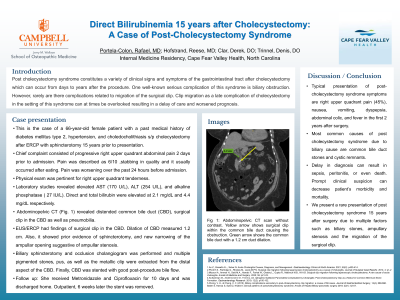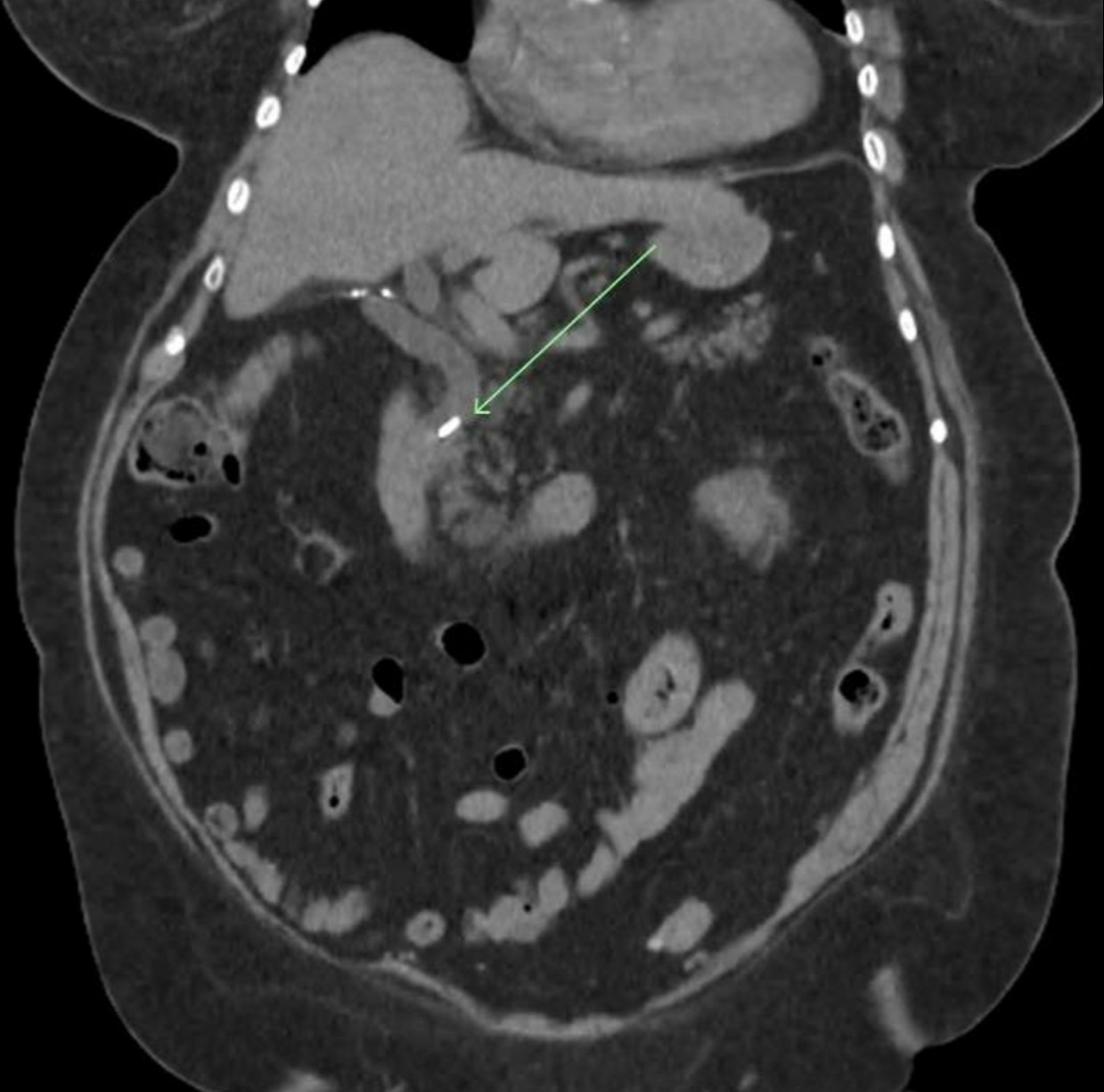Back


Poster Session A - Sunday Afternoon
Category: Biliary/Pancreas
A0035 - Direct Bilirubinemia 15 Years After Cholecystectomy: A Case of Post-Cholecystectomy Syndrome
Sunday, October 23, 2022
5:00 PM – 7:00 PM ET
Location: Crown Ballroom

Has Audio

Rafael Portela Colon, MD
Cape Fear Valley Hospital
Fayetteville, NC
Presenting Author(s)
Rafael Portela Colon, MD, Reese Hofstrand, MD, Dereck Clar, DO, Denis Trinnel, DO
Cape Fear Valley Hospital, Fayetteville, NC
Introduction: Post cholecystectomy syndrome constitutes a variety of clinical signs and symptoms of the GI tract after cholecystectomy which can occur from days to years after the procedure. One of the well-known serious complications is biliary obstruction. However, rarely are there complications related to migration of the surgical clip. Clip migration as a late complication of cholecystectomy in the setting of this syndrome can at times be overlooked resulting in a delay of care and worsened prognosis.
Case Description/Methods: We present a 66-year-old female patient with a past medical history of diabetes, hypertension, and choledocholithiasis s/p cholecystectomy after ERCP with sphincterotomy 15 years prior who presented to the emergency department with acute and progressive right upper quadrant abdominal pain for 2 days. Initial physical exam revealed RUQ abdominal tenderness without Murphy's sign. Patient was afebrile and tachycardic. Laboratory studies revealed elevated AST, ALT, alkaline phosphatase 170 U/L, 254 U/L, and 227 IU/L respectively. Direct and total bilirubin were elevated at 2.1 mg/dL and 4.4 mg/dL respectively. CBC was unremarkable. CT abdomen/pelvis without IV contrast showed CBD of 1.2cm, surgical clip in the CBD as well as pneumobilia. The patient underwent EUS/ERCP with findings of surgical clip in the CBD, 1 cm dilation of the CBD, prior evidence of sphincterotomy, and new narrowing of the ampullar opening suggestive of ampullar stenosis. Biliary sphincterotomy and occlusion cholangiogram was performed and multiple pigmented stones, pus, as well as the metallic clip were extracted from the distal aspect of the CBD. Finally, CBD was stented with good post-procedure bile flow. Patient was discharged to complete 10 days of antibiotics.
Discussion: One of the interesting and unusual aspects of this case was her late presentation with classic features of choledocholithiasis and “cholecystitis” with prior history of cholecystectomy. Additionally, multiple factors contributed to her clinical picture, including biliary stones, surgical clip, as well as ampullary stenosis even with history of sphincterotomy. The above findings could represent multiple etiologies for patients signs and symptoms in this rare case of post cholecystectomy syndrome.

Disclosures:
Rafael Portela Colon, MD, Reese Hofstrand, MD, Dereck Clar, DO, Denis Trinnel, DO. A0035 - Direct Bilirubinemia 15 Years After Cholecystectomy: A Case of Post-Cholecystectomy Syndrome, ACG 2022 Annual Scientific Meeting Abstracts. Charlotte, NC: American College of Gastroenterology.
Cape Fear Valley Hospital, Fayetteville, NC
Introduction: Post cholecystectomy syndrome constitutes a variety of clinical signs and symptoms of the GI tract after cholecystectomy which can occur from days to years after the procedure. One of the well-known serious complications is biliary obstruction. However, rarely are there complications related to migration of the surgical clip. Clip migration as a late complication of cholecystectomy in the setting of this syndrome can at times be overlooked resulting in a delay of care and worsened prognosis.
Case Description/Methods: We present a 66-year-old female patient with a past medical history of diabetes, hypertension, and choledocholithiasis s/p cholecystectomy after ERCP with sphincterotomy 15 years prior who presented to the emergency department with acute and progressive right upper quadrant abdominal pain for 2 days. Initial physical exam revealed RUQ abdominal tenderness without Murphy's sign. Patient was afebrile and tachycardic. Laboratory studies revealed elevated AST, ALT, alkaline phosphatase 170 U/L, 254 U/L, and 227 IU/L respectively. Direct and total bilirubin were elevated at 2.1 mg/dL and 4.4 mg/dL respectively. CBC was unremarkable. CT abdomen/pelvis without IV contrast showed CBD of 1.2cm, surgical clip in the CBD as well as pneumobilia. The patient underwent EUS/ERCP with findings of surgical clip in the CBD, 1 cm dilation of the CBD, prior evidence of sphincterotomy, and new narrowing of the ampullar opening suggestive of ampullar stenosis. Biliary sphincterotomy and occlusion cholangiogram was performed and multiple pigmented stones, pus, as well as the metallic clip were extracted from the distal aspect of the CBD. Finally, CBD was stented with good post-procedure bile flow. Patient was discharged to complete 10 days of antibiotics.
Discussion: One of the interesting and unusual aspects of this case was her late presentation with classic features of choledocholithiasis and “cholecystitis” with prior history of cholecystectomy. Additionally, multiple factors contributed to her clinical picture, including biliary stones, surgical clip, as well as ampullary stenosis even with history of sphincterotomy. The above findings could represent multiple etiologies for patients signs and symptoms in this rare case of post cholecystectomy syndrome.

Figure: Fig 1: CT scan of abdomen and pelvis without IV or PO contrast demonstrating prior cholecystectomy with a cholecystectomy clip within the common bile duct causing a 1.2cm duct dilation.
Disclosures:
Rafael Portela Colon indicated no relevant financial relationships.
Reese Hofstrand indicated no relevant financial relationships.
Dereck Clar indicated no relevant financial relationships.
Denis Trinnel indicated no relevant financial relationships.
Rafael Portela Colon, MD, Reese Hofstrand, MD, Dereck Clar, DO, Denis Trinnel, DO. A0035 - Direct Bilirubinemia 15 Years After Cholecystectomy: A Case of Post-Cholecystectomy Syndrome, ACG 2022 Annual Scientific Meeting Abstracts. Charlotte, NC: American College of Gastroenterology.
